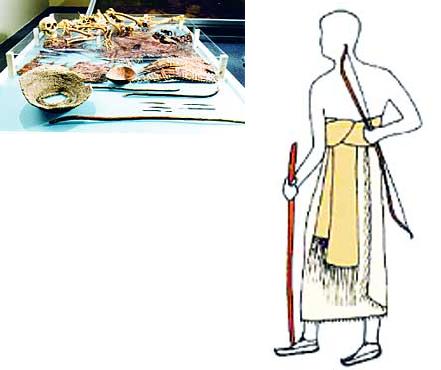Archeology / It is estimated that this is a nobleman from the Rihu region - perhaps the ruler of the region - who was buried in the Qumran caves
Lior Kodner, Haaretz, Walla News

The view of the tomb and the figure of the nobleman (below). Bones typical of those with developed muscles Source: Israel Museum
For more than 50 years, archaeologists from many parts of the world have been scanning the area of the northern Dead Sea, in search of the buried scrolls. About 10 years ago, the researchers encountered another significant discovery, in one of the Qumran caves: the body of Atzil, who apparently lived in the Jericho area about 6,000 years ago. Starting this week, after years of restoration, the discovery is on display at the Israel Museum in Jerusalem.
In 1993, a delegation of archaeologists from the Israel Antiquities Authority arrived in the Judean Desert to search for additional scroll fragments. Scanning a small cave in the southern cliff of Wadi al-Makhuch, overlooking Jericho, they found a single coin from the Hasmonean period. One of the researchers wanted to further investigate the place, and found tiny pieces of cloth in the cave. Following the discovery, a large delegation of archaeologists came to the site for an orderly excavation.
First, a bundle of coins was uncovered, which testified that the cave was once visited by a Hasmonean guest. Next to the coins, the archaeologists found a pile of cloth placed on a mat, and in it a human skeleton laid in the fetal position. According to the researchers, this position suggests an ancient belief, which links death with rebirth.
Thanks to the dry climate in the Judean desert, the tomb was kept in good condition. The nobleman was discovered wearing a wrap skirt, and a long and fancy belt around his waist. On his feet were leather sandals and by his side a walking stick. In addition, a magnificent bow was found in the tomb. A 30-centimeter-long flint knife was placed next to the body - a status symbol at that time.
The body was wrapped in an unusual shroud - a linen fabric, seven meters long and two meters wide, which remained almost intact. The ends of the cloth were decorated with painted threads and the entire sheet was woven, apparently, by the hands of at least three weavers, on a large loom. The sheet was folded twice into a kind of four-layer envelope, inside which the nobleman was placed.
The examination of the artifacts revealed that the skeleton is about 6,000 years old, from the end of the Chalcolithic period. During this period, the caves of the Judean desert served as a place of refuge and hiding in times of distress and crisis; In rare cases they were also used for burial.
According to the researchers, the nobleman was a very tall man for his time - about 170 centimeters. He died at the end of his fourth decade, an extreme age in those days. The craniotomy showed
The man's nose was tilted to the left, probably because of a fracture, and that he had lost many of his teeth. The bones of his hands and feet are typical of those with developed muscles. At the end of his life, he broke the tibia above his ankle, so he used a walking stick. The cause of his death is unclear.
According to the researchers, the burial place and the wealth of objects found next to the skeleton prove that it was the ruler of the area, maybe even a priest. The noble probably lived in Jericho or a nearby settlement
. In the burial ceremony, his body and the objects accompanying the burial were anointed with a red paste produced from the ocher iron ore. The color of the ointment, like the color of blood, is associated among many cultures with the power to create life and bring about its renewal.
"This man lived in a very pastoral period in the Israeli landscape," says exhibition curator Osnat Mish-Brendel. "At that time there were mainly unestablished settlements in our area, where several thousand people lived. They came up with amazing techniques of working gold, metal and stone. They also had an amazing culture of the arts, and then suddenly they disappeared."
https://www.hayadan.org.il/BuildaGate4/general2/data_card.php?Cat=~~~504595412~~~201&SiteName=hayadan

One response
Is there any additional material on the tomb near Jericho?
Especially interested in the arch - what it's made of, dimensions, etc.,.